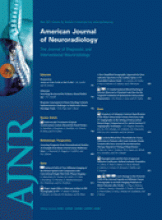We thank N. Anzalone and M. Cadioli for acknowledging the importance of our study on the added value of high-resolution (HR) MR imaging for the diagnosis of vertebral artery dissection (VAD).1 An early and reliable identification of VAD is important in preventing ischemic brain lesions. The diagnosis of cervical artery dissection is currently based on 1) a suggestive clinical presentation, 2) exclusion of atherosclerosis, and 3) supportive radiologic evidence. Obtaining radiologic evidence of VAD may be a real challenge, given the highly tortuous course of vertebral arteries, the great variability in normal-vessel caliber, the presence of the thick bony covering, and adjacent veins. The emergence of HR rapid imaging methods has enabled MR imaging to noninvasively image the fine internal structure of cervical artery walls. There is now solid evidence that HR MR imaging can identify the major components of atherosclerotic plaque (ie, lipid core, mural hemorrhage, calcifications, and the fibrous cap).2 This enables differentiating stable and unstable atherosclerotic plaques.3
Beyond atherosclerosis, HR MR imaging can be used further in case of suspicion of cervical artery dissection, providing an excellent visualization of the cervical artery mural hematoma on both carotid and vertebral arteries.4–6 We demonstrated the usefulness of HR MR imaging in patients who are suspected of having VAD, for whom conventional imaging work-up is inconclusive. However, one can question how far we should go with HR. Because of the limited accessibility of HR MR imaging and the long scanning time inherent to the technique, the idea is not to perform HR MR imaging in all patients with VAD but rather to improve our imaging protocols to get supportive imaging evidence in most patients. This is already feasible by using 3T MR magnets with standard multichannel head and neck coils. The bonus signal intensity–to-noise ratio of 3T can be targeted at improving spatial resolution without the need of an additional dedicated surface coil. In daily practice, 3T fat-suppressed T1- and T2-weighted sequences with 3-mm section thickness challenge the HR obtained by using a dedicated surface coil with a 1.5T MR imaging unit (ie, 500 × 500 μm × 3 mm) to image the walls of the cervical arteries. HR MR imaging at 1.5T prefigures tomorrow's 3T imaging.
References
- Copyright © American Society of Neuroradiology












